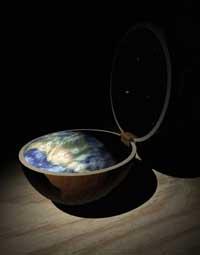The Earth's surface absorbed the early years
2001/08/06 Astobiza, Amaia

In the first two billion years of Earth's history, there was hardly any oxygen in the atmosphere. Subsequently, for reasons still unclear, the oxygen level began to rise. Recently a group of scientists studying the atmosphere has explained that it has discovered the reason for this change. According to them, bacterial development meant a change in the balance of Earth's gases, which reduced the amount of methane and raised oxygen levels.
Until about 400 million years after the formation of bacteria, the atmospheric oxygen level was very low. However, research has not clarified the reason. According to the most accepted theory so far, the composition of the gases of the volcanoes changed and finally, by reacting with atmospheric gases, they consumed less oxygen. However, studies in recent years have turned this theory upside down.

Now the theory of bacteria has been imposed. Bacteria release methane when they break down dead matter. According to NASA scientist David Catling and his coworkers, the released methane was stored in the upper atmosphere, where solar energy caused the breakdown of methane and the formation of carbon and hydrogen. Hydrogen, the lightest, expanded into space. This loss of hydrogen caused a change in the balance of terrestrial elements and, 400 million years later, an increase in oxygen level.
Why did it take so long? Catling and his companions believe that the earth's surface was initially able to absorb all oxygen. However, some 2.3 billion years ago, the rocks on the earth's surface began to tighten and deform, which prevented the absorption of all the oxygen produced by bacteria. Then oxygen began to be stored in the atmosphere and little by little the atmosphere we know today was formed.

Gai honi buruzko eduki gehiago
Elhuyarrek garatutako teknologia





